BMW M6 CONVERTIBLE 2014 F12M Owner's Manual
Manufacturer: BMW, Model Year: 2014, Model line: M6 CONVERTIBLE, Model: BMW M6 CONVERTIBLE 2014 F12MPages: 228, PDF Size: 5.02 MB
Page 161 of 228
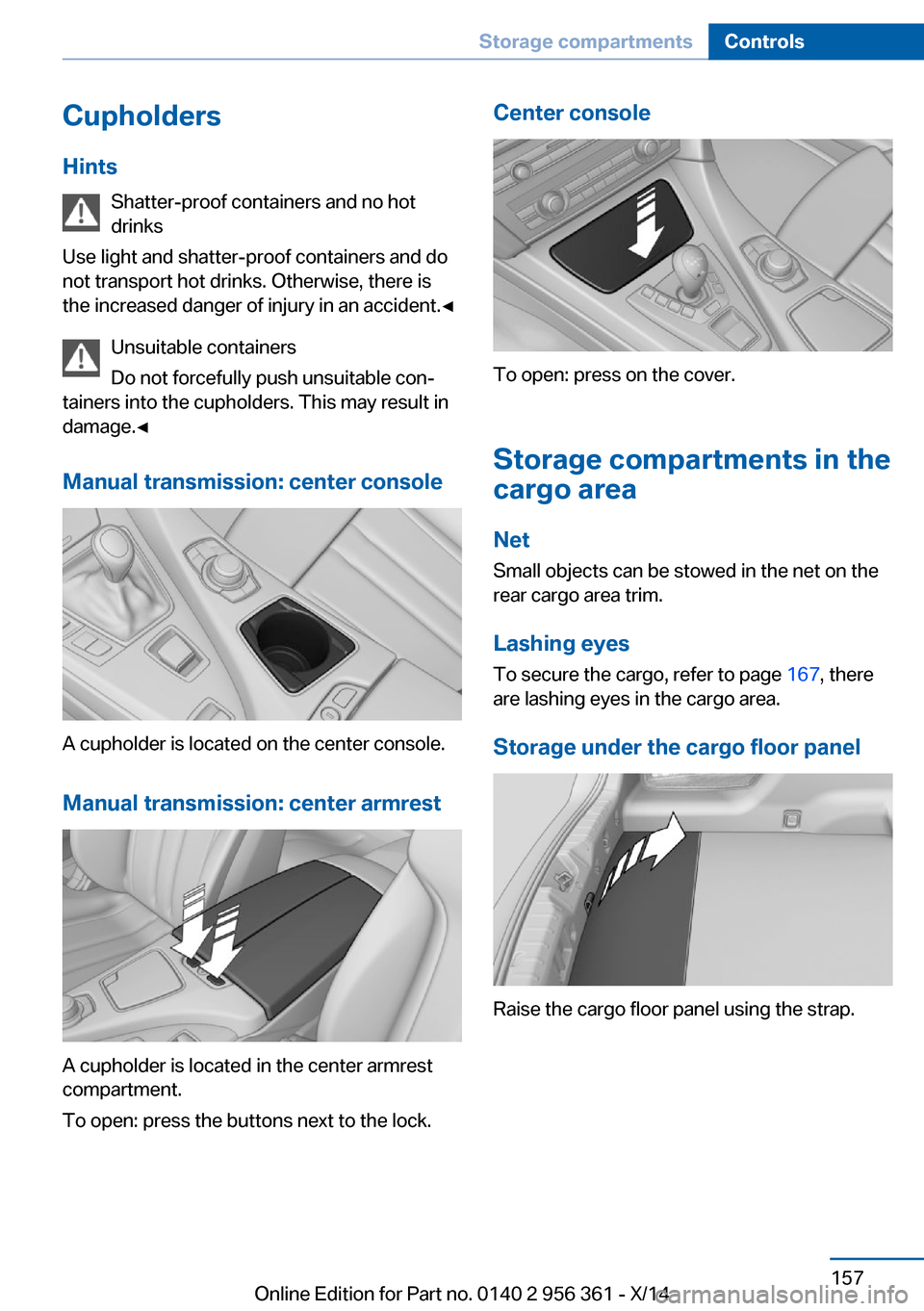
Cupholders
Hints Shatter-proof containers and no hot
drinks
Use light and shatter-proof containers and do
not transport hot drinks. Otherwise, there is the increased danger of injury in an accident.â
Unsuitable containers
Do not forcefully push unsuitable conâ
tainers into the cupholders. This may result in
damage.â
Manual transmission: center console
A cupholder is located on the center console.
Manual transmission: center armrest
A cupholder is located in the center armrest
compartment.
To open: press the buttons next to the lock.
Center console
To open: press on the cover.
Storage compartments in the
cargo area
Net Small objects can be stowed in the net on the
rear cargo area trim.
Lashing eyes To secure the cargo, refer to page 167, there
are lashing eyes in the cargo area.
Storage under the cargo floor panel
Raise the cargo floor panel using the strap.
Seite 157Storage compartmentsControls157
Online Edition for Part no. 0140 2 956 361 - X/14
Page 162 of 228
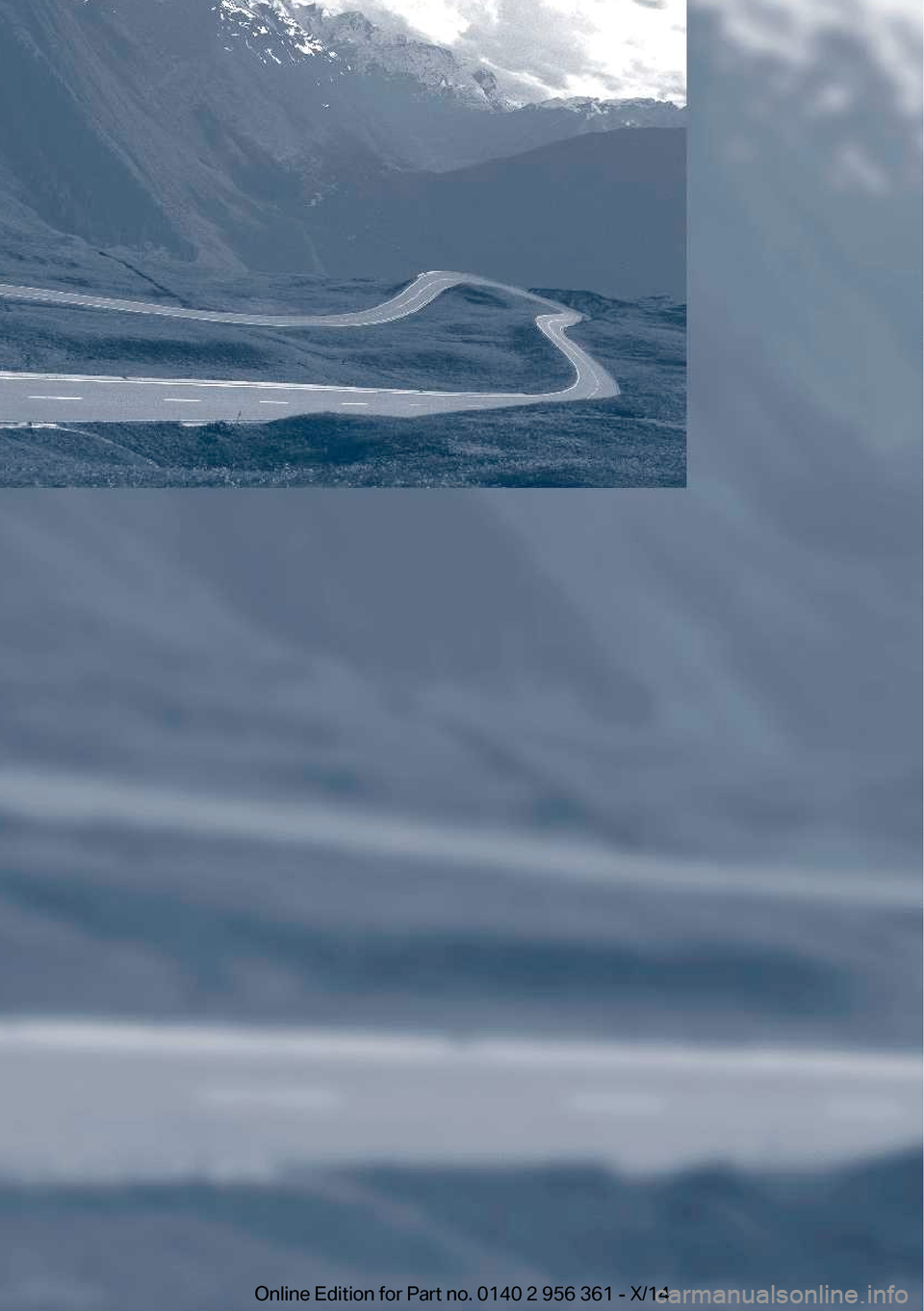
Online Edition for Part no. 0140 2 956 361 - X/14
Page 163 of 228
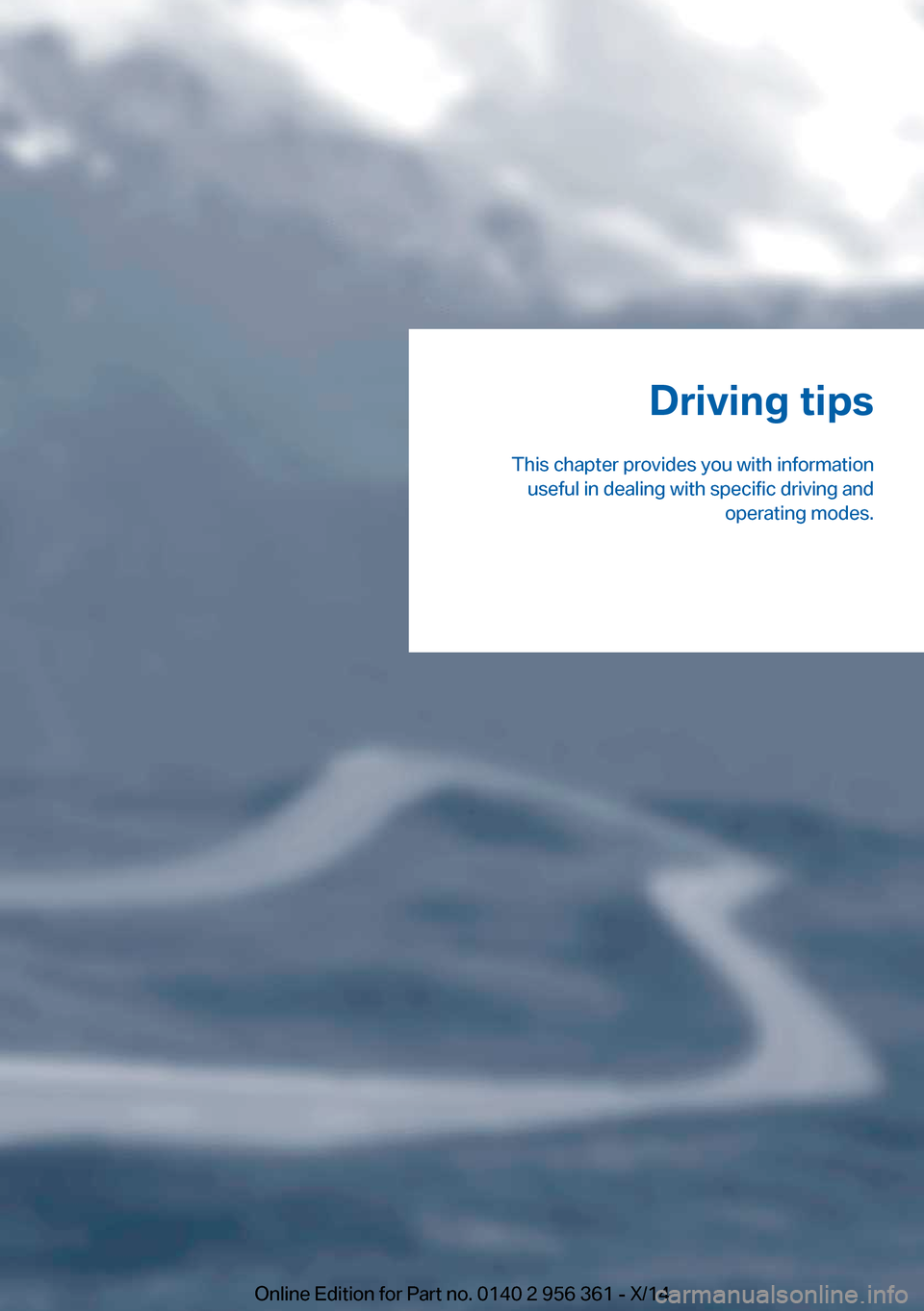
Driving tips
This chapter provides you with information useful in dealing with specific driving and operating modes.Online Edition for Part no. 0140 2 956 361 - X/14
Page 164 of 228
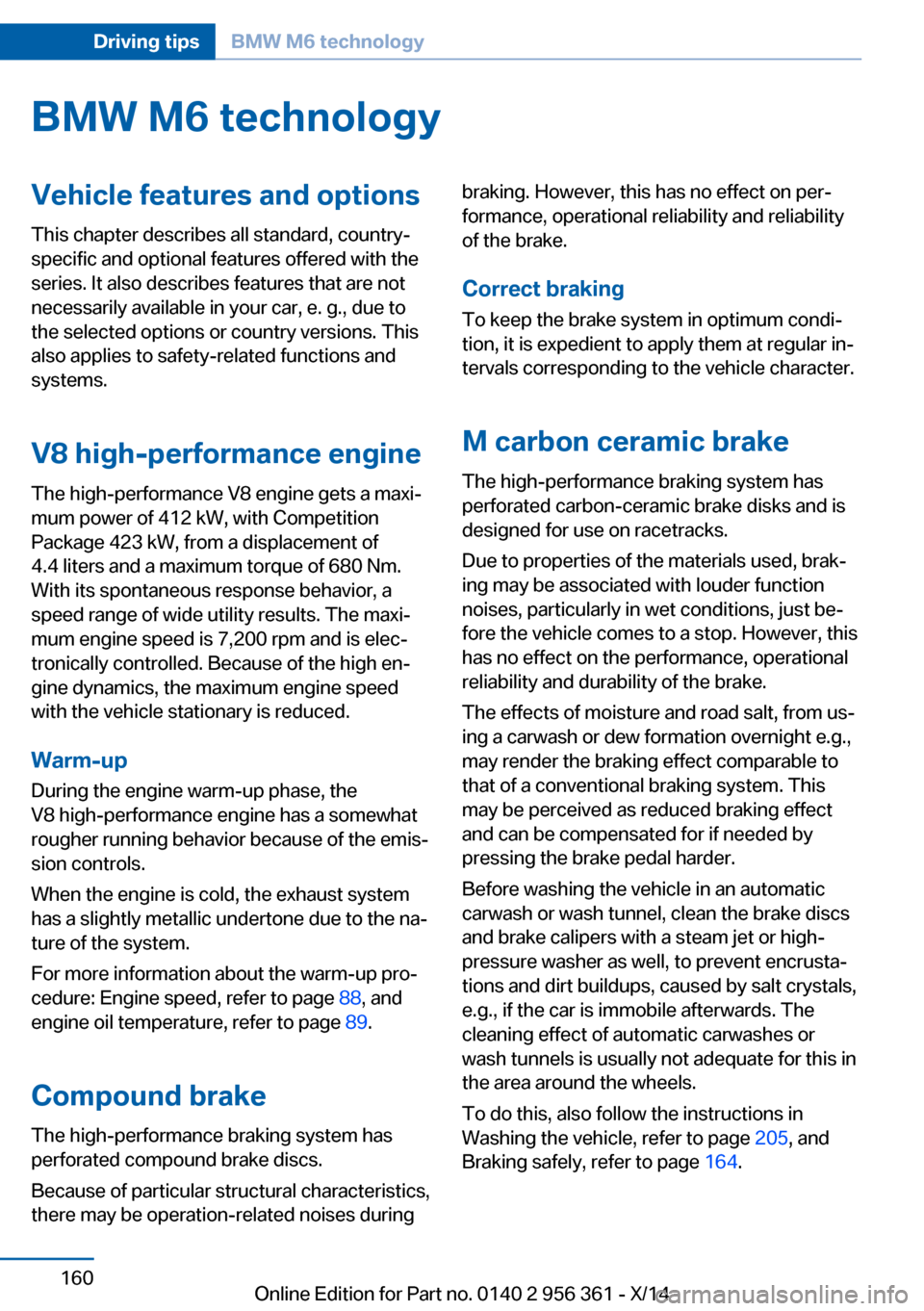
BMW M6 technologyVehicle features and options
This chapter describes all standard, country-
specific and optional features offered with the
series. It also describes features that are not
necessarily available in your car, e. g., due to
the selected options or country versions. This
also applies to safety-related functions and
systems.
V8 high-performance engine
The high-performance V8 engine gets a maxiâ
mum power of 412 kW, with Competition
Package 423 kW, from a displacement of
4.4 liters and a maximum torque of 680 Nm.
With its spontaneous response behavior, a
speed range of wide utility results. The maxiâ
mum engine speed is 7,200 rpm and is elecâ
tronically controlled. Because of the high enâ
gine dynamics, the maximum engine speed
with the vehicle stationary is reduced.
Warm-up
During the engine warm-up phase, the
V8 high-performance engine has a somewhat
rougher running behavior because of the emisâ
sion controls.
When the engine is cold, the exhaust system
has a slightly metallic undertone due to the naâ
ture of the system.
For more information about the warm-up proâ
cedure: Engine speed, refer to page 88, and
engine oil temperature, refer to page 89.
Compound brake
The high-performance braking system has
perforated compound brake discs.
Because of particular structural characteristics,
there may be operation-related noises duringbraking. However, this has no effect on perâ
formance, operational reliability and reliability
of the brake.
Correct braking To keep the brake system in optimum condiâ
tion, it is expedient to apply them at regular inâ
tervals corresponding to the vehicle character.
M carbon ceramic brake
The high-performance braking system has
perforated carbon-ceramic brake disks and is
designed for use on racetracks.
Due to properties of the materials used, brakâ
ing may be associated with louder function
noises, particularly in wet conditions, just beâ
fore the vehicle comes to a stop. However, this
has no effect on the performance, operational
reliability and durability of the brake.
The effects of moisture and road salt, from usâ
ing a carwash or dew formation overnight e.g.,
may render the braking effect comparable to
that of a conventional braking system. This
may be perceived as reduced braking effect
and can be compensated for if needed by
pressing the brake pedal harder.
Before washing the vehicle in an automatic
carwash or wash tunnel, clean the brake discs
and brake calipers with a steam jet or high-
pressure washer as well, to prevent encrustaâ
tions and dirt buildups, caused by salt crystals,
e.g., if the car is immobile afterwards. The
cleaning effect of automatic carwashes or
wash tunnels is usually not adequate for this in
the area around the wheels.
To do this, also follow the instructions in
Washing the vehicle, refer to page 205, and
Braking safely, refer to page 164.Seite 160Driving tipsBMW M6 technology160
Online Edition for Part no. 0140 2 956 361 - X/14
Page 165 of 228
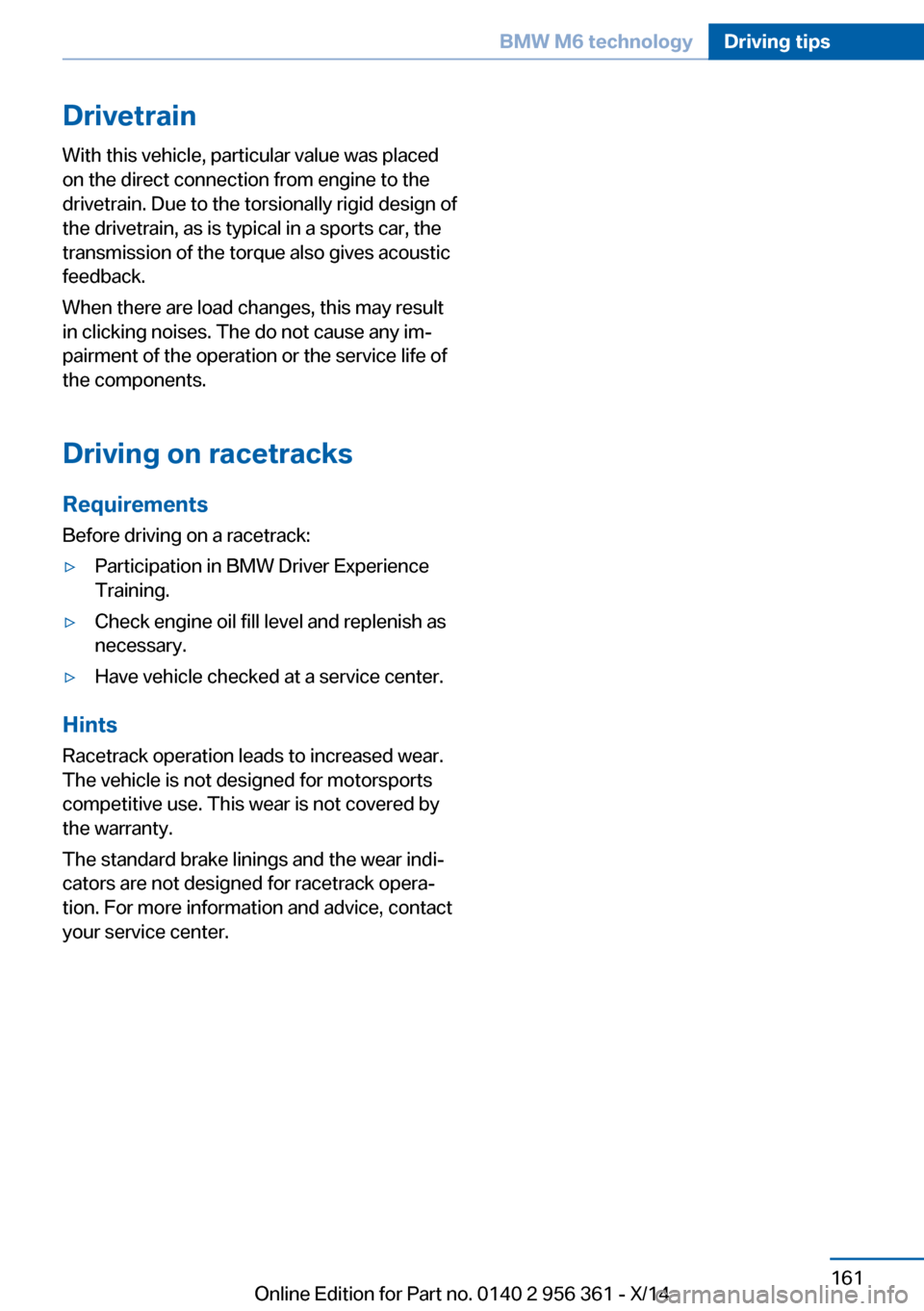
Drivetrain
With this vehicle, particular value was placed
on the direct connection from engine to the
drivetrain. Due to the torsionally rigid design of
the drivetrain, as is typical in a sports car, the
transmission of the torque also gives acoustic
feedback.
When there are load changes, this may result
in clicking noises. The do not cause any imâ
pairment of the operation or the service life of
the components.
Driving on racetracks
Requirements
Before driving on a racetrack:âˇParticipation in BMW Driver Experience
Training.âˇCheck engine oil fill level and replenish as
necessary.âˇHave vehicle checked at a service center.
Hints
Racetrack operation leads to increased wear.
The vehicle is not designed for motorsports
competitive use. This wear is not covered by
the warranty.
The standard brake linings and the wear indiâ
cators are not designed for racetrack operaâ
tion. For more information and advice, contact
your service center.
Seite 161BMW M6 technologyDriving tips161
Online Edition for Part no. 0140 2 956 361 - X/14
Page 166 of 228
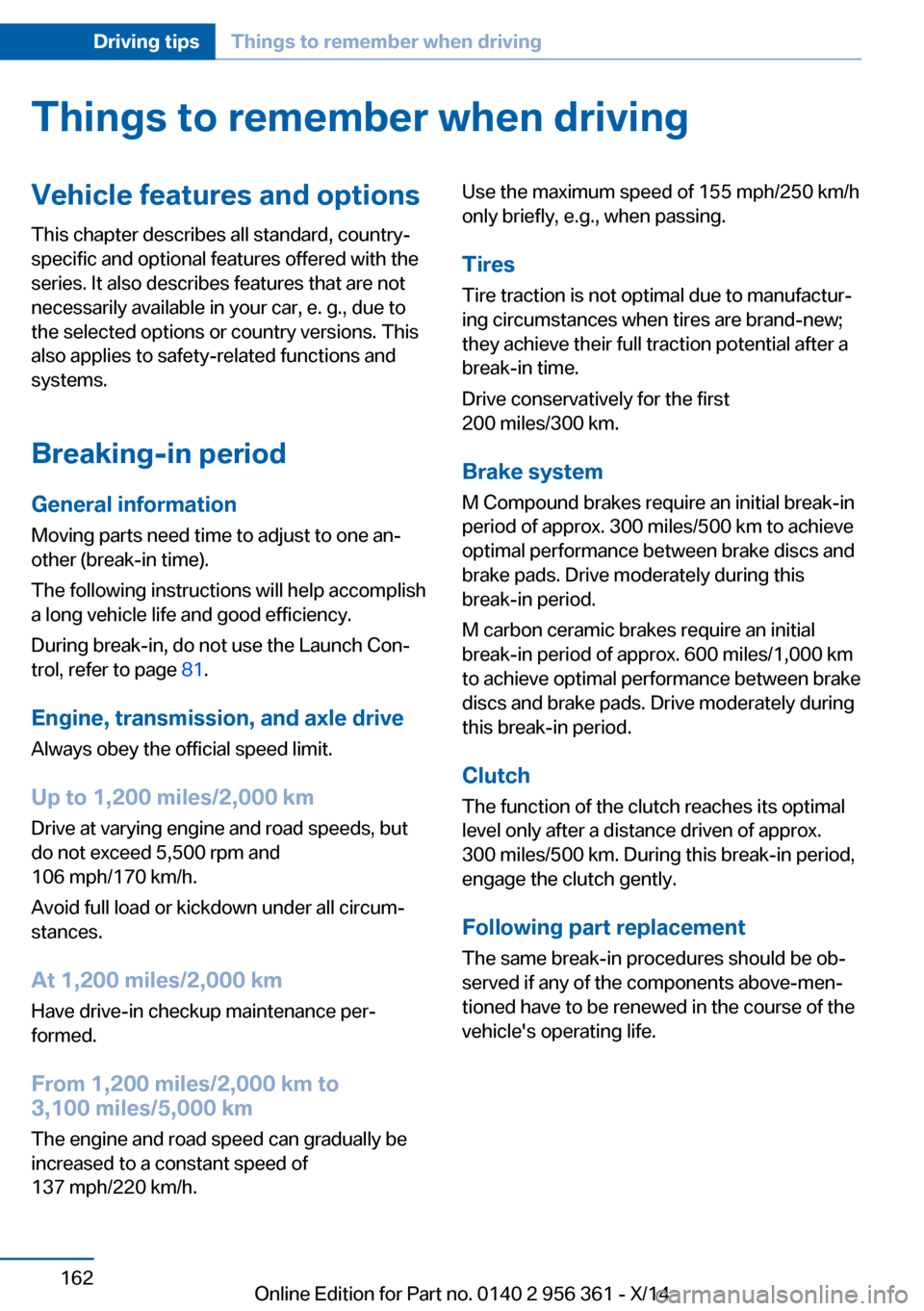
Things to remember when drivingVehicle features and options
This chapter describes all standard, country-
specific and optional features offered with the
series. It also describes features that are not
necessarily available in your car, e. g., due to
the selected options or country versions. This
also applies to safety-related functions and
systems.
Breaking-in period
General information Moving parts need time to adjust to one anâ
other (break-in time).
The following instructions will help accomplish
a long vehicle life and good efficiency.
During break-in, do not use the Launch Conâ
trol, refer to page 81.
Engine, transmission, and axle drive Always obey the official speed limit.
Up to 1,200 miles/2,000 km
Drive at varying engine and road speeds, but
do not exceed 5,500 rpm and
106 mph/170 km/h.
Avoid full load or kickdown under all circumâ
stances.
At 1,200 miles/2,000 km
Have drive-in checkup maintenance perâ
formed.
From 1,200 miles/2,000 km to 3,100 miles/5,000 km
The engine and road speed can gradually be
increased to a constant speed of
137 mph/220 km/h.Use the maximum speed of 155 mph/250 km/h
only briefly, e.g., when passing.
Tires
Tire traction is not optimal due to manufacturâ
ing circumstances when tires are brand-new;
they achieve their full traction potential after a
break-in time.
Drive conservatively for the first
200 miles/300 km.
Brake system
M Compound brakes require an initial break-in
period of approx. 300 miles/500 km to achieve
optimal performance between brake discs and
brake pads. Drive moderately during this
break-in period.
M carbon ceramic brakes require an initial
break-in period of approx. 600 miles/1,000 km
to achieve optimal performance between brake
discs and brake pads. Drive moderately during
this break-in period.
Clutch
The function of the clutch reaches its optimal
level only after a distance driven of approx.
300 miles/500 km. During this break-in period,
engage the clutch gently.
Following part replacement
The same break-in procedures should be obâ
served if any of the components above-menâ
tioned have to be renewed in the course of the
vehicle's operating life.Seite 162Driving tipsThings to remember when driving162
Online Edition for Part no. 0140 2 956 361 - X/14
Page 167 of 228
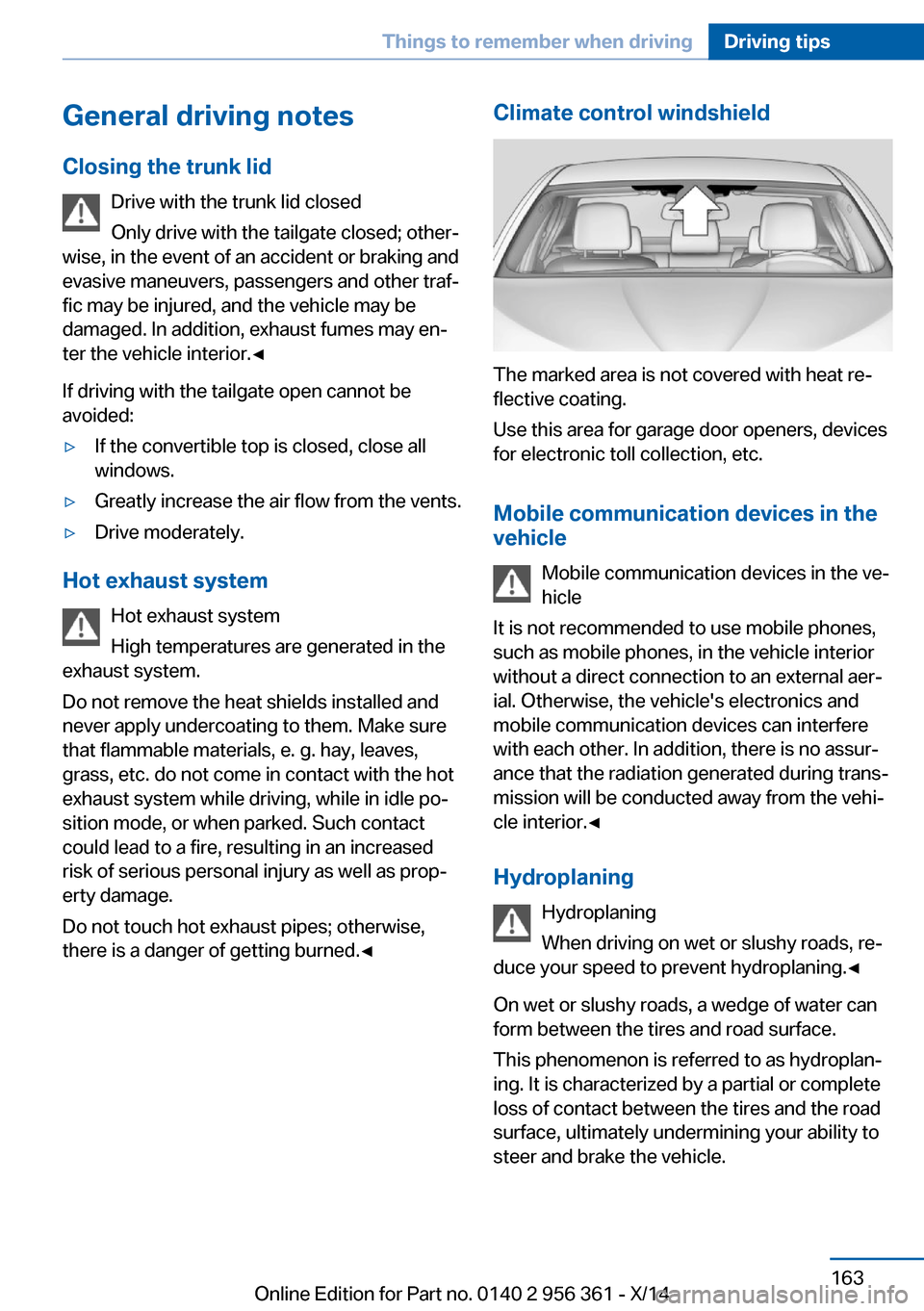
General driving notes
Closing the trunk lid Drive with the trunk lid closed
Only drive with the tailgate closed; otherâ
wise, in the event of an accident or braking and
evasive maneuvers, passengers and other trafâ
fic may be injured, and the vehicle may be
damaged. In addition, exhaust fumes may enâ
ter the vehicle interior.â
If driving with the tailgate open cannot be avoided:âˇIf the convertible top is closed, close all
windows.âˇGreatly increase the air flow from the vents.âˇDrive moderately.
Hot exhaust system
Hot exhaust system
High temperatures are generated in the
exhaust system.
Do not remove the heat shields installed and
never apply undercoating to them. Make sure
that flammable materials, e. g. hay, leaves,
grass, etc. do not come in contact with the hot
exhaust system while driving, while in idle poâ
sition mode, or when parked. Such contact
could lead to a fire, resulting in an increased
risk of serious personal injury as well as propâ
erty damage.
Do not touch hot exhaust pipes; otherwise,
there is a danger of getting burned.â
Climate control windshield
The marked area is not covered with heat reâ
flective coating.
Use this area for garage door openers, devices
for electronic toll collection, etc.
Mobile communication devices in the vehicle
Mobile communication devices in the veâ
hicle
It is not recommended to use mobile phones,
such as mobile phones, in the vehicle interior
without a direct connection to an external aerâ
ial. Otherwise, the vehicle's electronics and
mobile communication devices can interfere
with each other. In addition, there is no assurâ
ance that the radiation generated during transâ
mission will be conducted away from the vehiâ
cle interior.â
Hydroplaning Hydroplaning
When driving on wet or slushy roads, reâ
duce your speed to prevent hydroplaning.â
On wet or slushy roads, a wedge of water can
form between the tires and road surface.
This phenomenon is referred to as hydroplanâ
ing. It is characterized by a partial or complete
loss of contact between the tires and the road
surface, ultimately undermining your ability to
steer and brake the vehicle.
Seite 163Things to remember when drivingDriving tips163
Online Edition for Part no. 0140 2 956 361 - X/14
Page 168 of 228
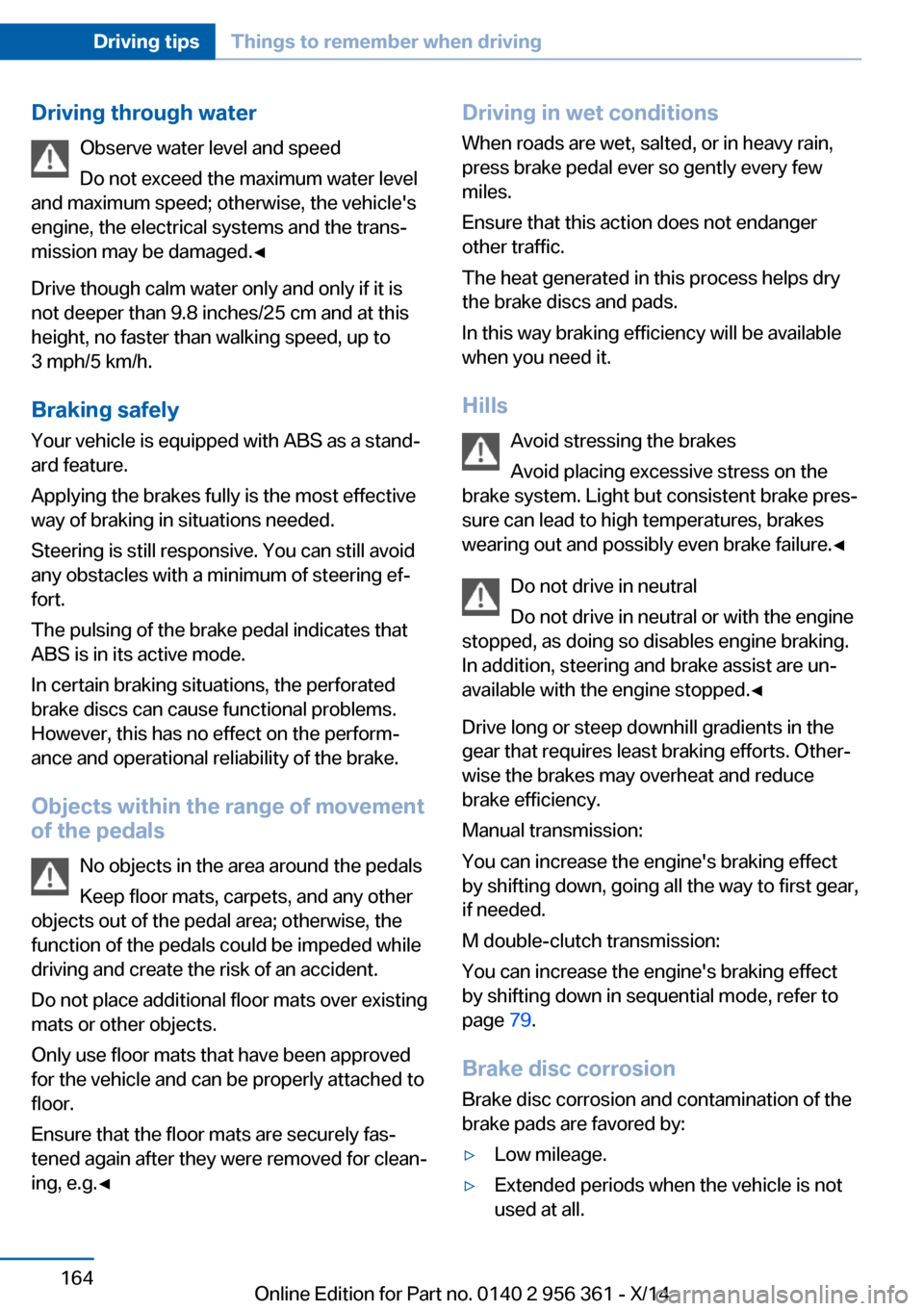
Driving through waterObserve water level and speed
Do not exceed the maximum water level
and maximum speed; otherwise, the vehicle's
engine, the electrical systems and the transâ
mission may be damaged.â
Drive though calm water only and only if it is
not deeper than 9.8 inches/25 cm and at this
height, no faster than walking speed, up to
3 mph/5 km/h.
Braking safely
Your vehicle is equipped with ABS as a standâ
ard feature.
Applying the brakes fully is the most effective
way of braking in situations needed.
Steering is still responsive. You can still avoid
any obstacles with a minimum of steering efâ
fort.
The pulsing of the brake pedal indicates that
ABS is in its active mode.
In certain braking situations, the perforated
brake discs can cause functional problems.
However, this has no effect on the performâ
ance and operational reliability of the brake.
Objects within the range of movement
of the pedals
No objects in the area around the pedals
Keep floor mats, carpets, and any other
objects out of the pedal area; otherwise, the
function of the pedals could be impeded while
driving and create the risk of an accident.
Do not place additional floor mats over existing
mats or other objects.
Only use floor mats that have been approved
for the vehicle and can be properly attached to
floor.
Ensure that the floor mats are securely fasâ
tened again after they were removed for cleanâ
ing, e.g.âDriving in wet conditions
When roads are wet, salted, or in heavy rain,
press brake pedal ever so gently every few
miles.
Ensure that this action does not endanger
other traffic.
The heat generated in this process helps dry
the brake discs and pads.
In this way braking efficiency will be available
when you need it.
Hills Avoid stressing the brakes
Avoid placing excessive stress on the
brake system. Light but consistent brake presâ
sure can lead to high temperatures, brakes
wearing out and possibly even brake failure.â
Do not drive in neutral
Do not drive in neutral or with the engine
stopped, as doing so disables engine braking.
In addition, steering and brake assist are unâ
available with the engine stopped.â
Drive long or steep downhill gradients in the
gear that requires least braking efforts. Otherâ
wise the brakes may overheat and reduce
brake efficiency.
Manual transmission:
You can increase the engine's braking effect
by shifting down, going all the way to first gear,
if needed.
M double-clutch transmission:
You can increase the engine's braking effect
by shifting down in sequential mode, refer to
page 79.
Brake disc corrosion
Brake disc corrosion and contamination of the
brake pads are favored by:âˇLow mileage.âˇExtended periods when the vehicle is not
used at all.Seite 164Driving tipsThings to remember when driving164
Online Edition for Part no. 0140 2 956 361 - X/14
Page 169 of 228
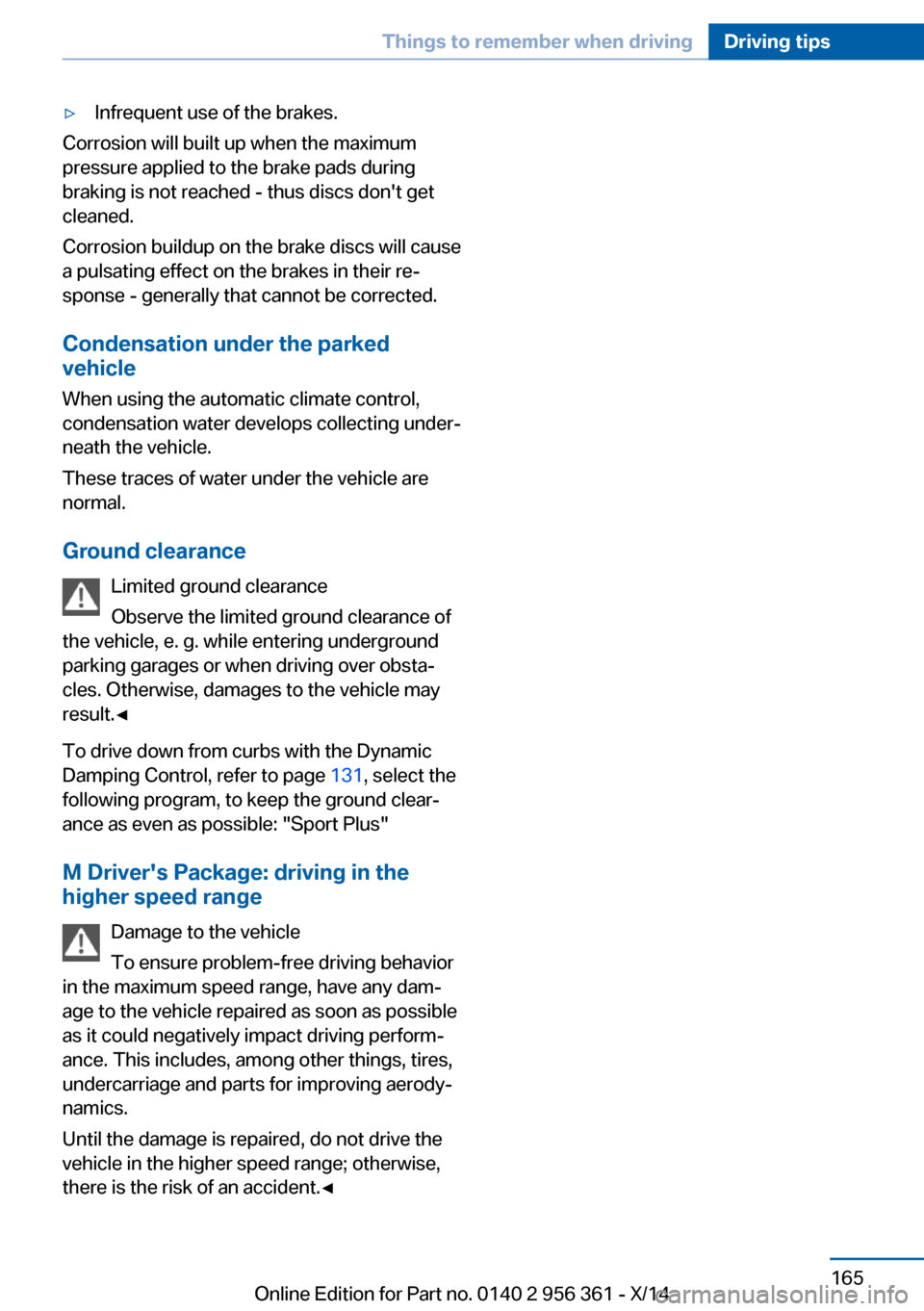
âˇInfrequent use of the brakes.
Corrosion will built up when the maximum
pressure applied to the brake pads during
braking is not reached - thus discs don't get
cleaned.
Corrosion buildup on the brake discs will cause
a pulsating effect on the brakes in their reâ
sponse - generally that cannot be corrected.
Condensation under the parked
vehicle
When using the automatic climate control,
condensation water develops collecting underâ
neath the vehicle.
These traces of water under the vehicle are
normal.
Ground clearance Limited ground clearance
Observe the limited ground clearance of
the vehicle, e. g. while entering underground
parking garages or when driving over obstaâ
cles. Otherwise, damages to the vehicle may
result.â
To drive down from curbs with the Dynamic
Damping Control, refer to page 131, select the
following program, to keep the ground clearâ
ance as even as possible: "Sport Plus"
M Driver's Package: driving in thehigher speed range
Damage to the vehicle
To ensure problem-free driving behavior
in the maximum speed range, have any damâ
age to the vehicle repaired as soon as possible
as it could negatively impact driving performâ
ance. This includes, among other things, tires,
undercarriage and parts for improving aerodyâ namics.
Until the damage is repaired, do not drive the
vehicle in the higher speed range; otherwise,
there is the risk of an accident.â
Seite 165Things to remember when drivingDriving tips165
Online Edition for Part no. 0140 2 956 361 - X/14
Page 170 of 228
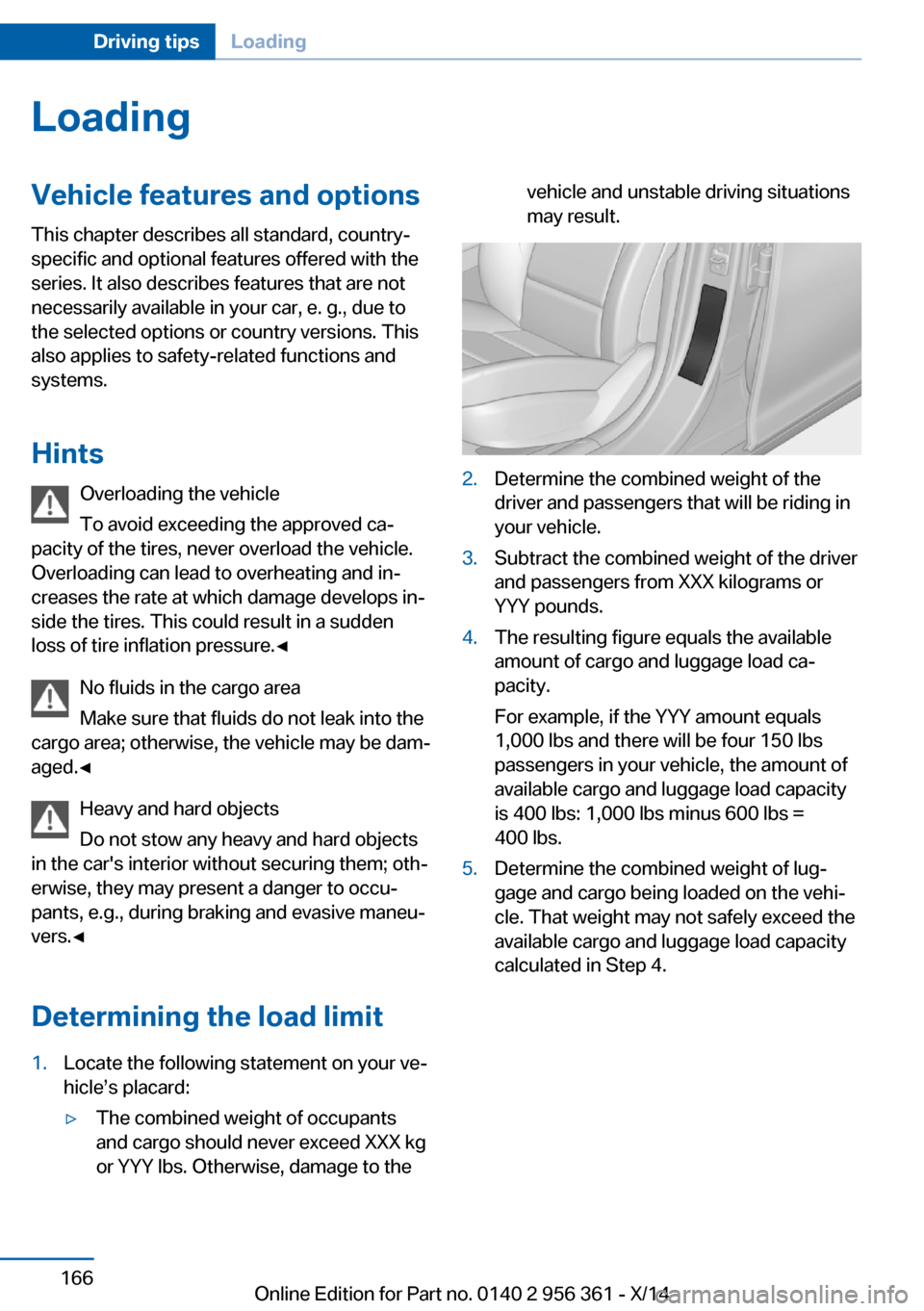
LoadingVehicle features and options
This chapter describes all standard, country-
specific and optional features offered with the
series. It also describes features that are not
necessarily available in your car, e. g., due to
the selected options or country versions. This
also applies to safety-related functions and
systems.
Hints Overloading the vehicle
To avoid exceeding the approved caâ
pacity of the tires, never overload the vehicle.
Overloading can lead to overheating and inâ
creases the rate at which damage develops inâ
side the tires. This could result in a sudden
loss of tire inflation pressure.â
No fluids in the cargo area
Make sure that fluids do not leak into the
cargo area; otherwise, the vehicle may be damâ
aged.â
Heavy and hard objects
Do not stow any heavy and hard objects
in the car's interior without securing them; othâ
erwise, they may present a danger to occuâ
pants, e.g., during braking and evasive maneuâ
vers.â
Determining the load limit1.Locate the following statement on your veâ
hicleâs placard:âˇThe combined weight of occupants
and cargo should never exceed XXX kg
or YYY lbs. Otherwise, damage to thevehicle and unstable driving situations
may result.2.Determine the combined weight of the
driver and passengers that will be riding in
your vehicle.3.Subtract the combined weight of the driver
and passengers from XXX kilograms or
YYY pounds.4.The resulting figure equals the available
amount of cargo and luggage load caâ
pacity.
For example, if the YYY amount equals
1,000 lbs and there will be four 150 lbs
passengers in your vehicle, the amount of
available cargo and luggage load capacity
is 400 lbs: 1,000 lbs minus 600 lbs =
400 lbs.5.Determine the combined weight of lugâ
gage and cargo being loaded on the vehiâ
cle. That weight may not safely exceed the
available cargo and luggage load capacity
calculated in Step 4.Seite 166Driving tipsLoading166
Online Edition for Part no. 0140 2 956 361 - X/14